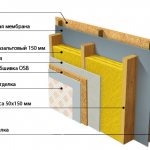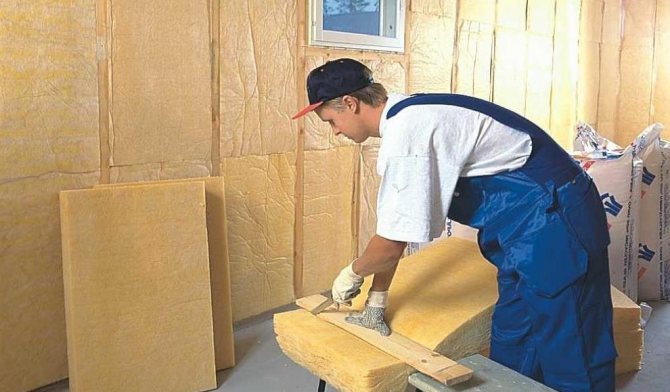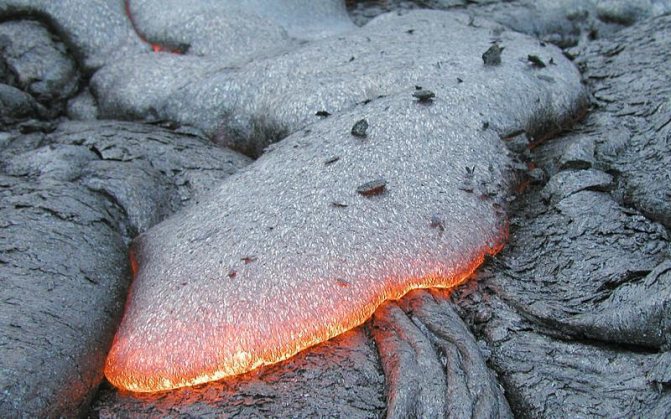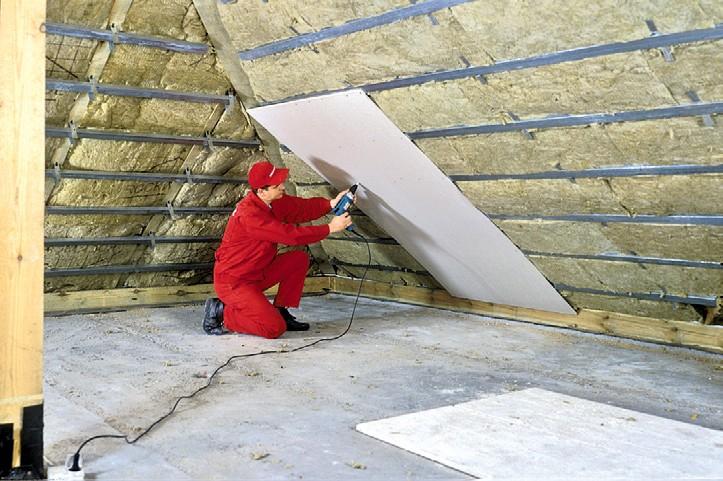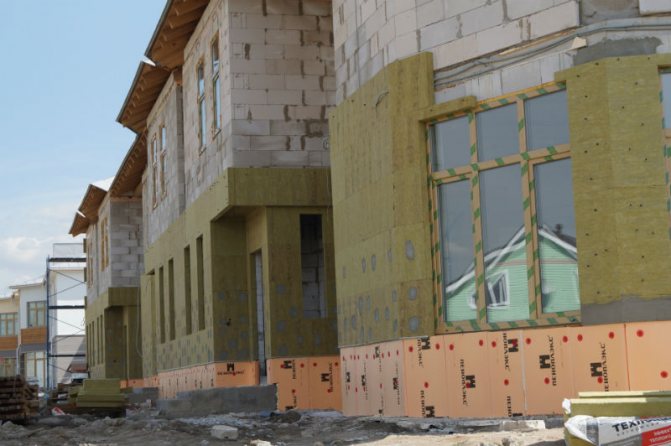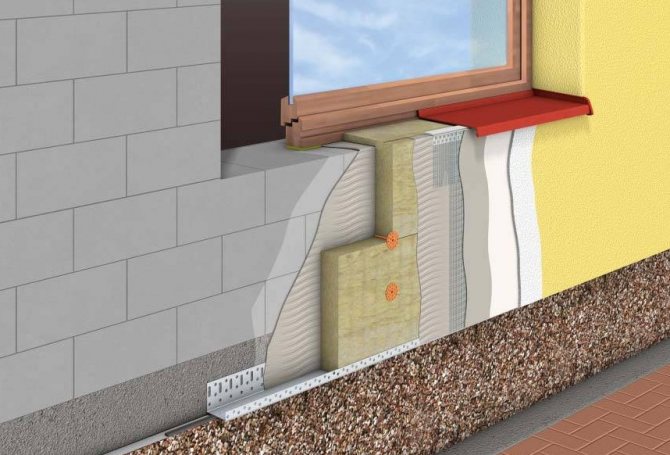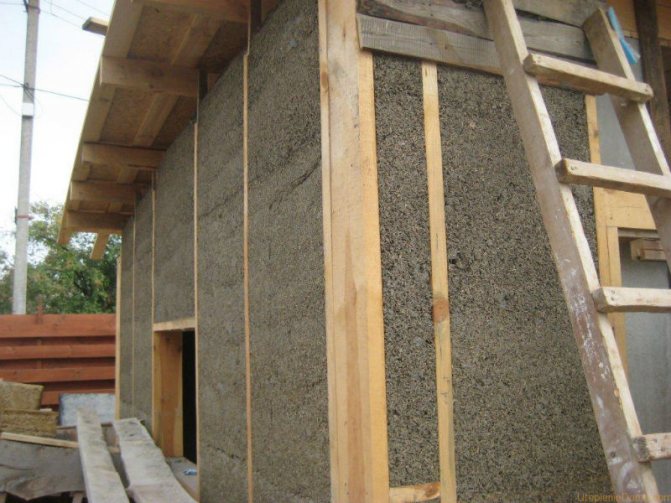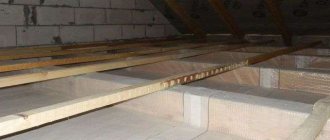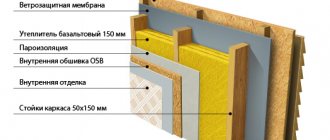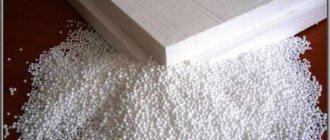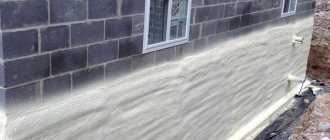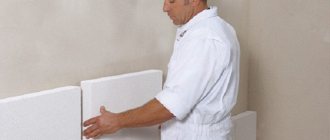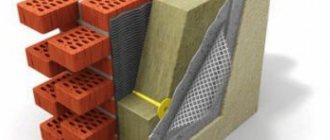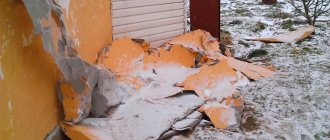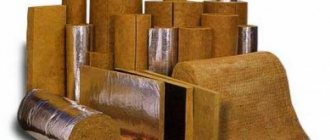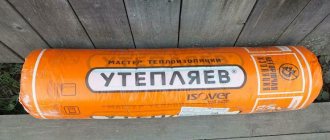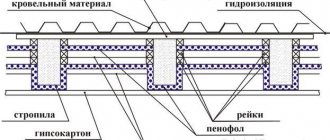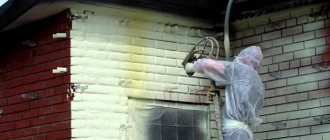Basalt wool is considered one of the highest quality and most widely used heat insulators today.
Made from natural materials, it is safe for residential use. It can be encountered when decorating a house, in the process of building buildings for various purposes. No less widely, this building material is used in the construction of private houses, as well as in the thermal insulation of air ducts.
The use of basalt wool is in demand to ensure thermal insulation of industrial equipment (boilers, boilers, furnaces), process pipelines and pipelines of heating networks. Basalt slabs can be used as unloaded sound and heat insulation in a horizontal enclosing structure of any type of building and structure. In addition, basalt insulation is used for thermal insulation, which is subjected to loads in horizontal, inclined and vertical building envelopes and other types of structures.
Thermal insulation of the roof with basalt wool
Insulation of roofs with basalt wool is a very common use of the material.
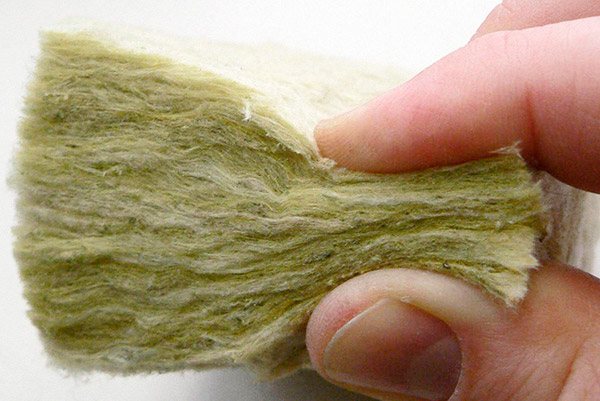
Today, special basalt slabs are on sale for roof insulation. The main advantages of such insulation are the incombustibility of the insulation, high soundproofing, good thermal insulation performance and ease of installation. Such material is produced in the form of plates, cylinders, mats, there is also foil insulation.
What is basalt wool
It has already been mentioned that basalt insulation belongs to the group of mineral materials. Its distinctive feature is the used production raw materials. To obtain the fibers of the future heat insulator, rock materials are used. Therefore, basalt wool is often called stone wool.
The production technology provides for the production of a liquid rock melt in a furnace at 1400-1500 ° C, from which the fiber is drawn. Binder components are used to bond the resulting fibers into a homogeneous array. The correct selection of the bonding base helps to significantly improve the characteristics of the stone wool. After the formation of the structure, setting the direction of the layers and obtaining the required density, the finished material is cut to a standard size and packed. Forms of production: mats, soft rolls, hard slabs.
Thermal insulation of facades
Basalt insulation is an optimal material for insulation with a set of characteristics that can solve many problems of thermal insulation in any type of structure: from an ordinary residential building to a large enterprise. This building material is resistant to fire, moisture, low temperatures.
Since basalt slabs are characterized by high strength and resistance to weathering, they are the best option for external insulation systems, the so-called thermal insulation of facades. Very often this type of insulation is used with the "wet" facade technology, where the building material does an excellent job with its main function - thermal insulation.


When insulating with basalt slabs, quartz soil, paint on a silicate or silicone base, decorative plaster are used. Silicone based paints allow facades to breathe.
For insulation, it is recommended to use a high-density insulation of 90-135 kg per cubic meter. m. The use of building materials with a lower density is not recommended, as this can lead to slipping of the basalt insulation.
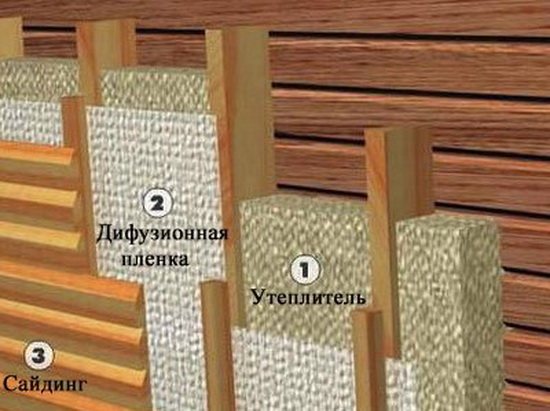

Unlike polystyrene, when installing basalt wool, a fastening such as an umbrella with a metal nail is used.This is due to the large weight of the material, which requires reliable fastening. Thermal insulation of facades with basalt wool is a laborious process and requires responsibility.
Insulation of internal walls
Wall insulation with basalt wool can also be performed from the inside of the building, where the building material demonstrates excellent thermal insulation properties. In addition, the insulation also performs the function of sound insulation.
Very often, mineral slabs can be found in the internal partitions of offices and apartments, where they are used to provide sound insulation. Vata absorbs sound very well. However, to isolate airborne noise, it is better to use looser slabs with a low density, and for shock noises it is advisable to use rigid and semi-rigid slabs and mats.
Insulation of a frame house
Warming a frame house with basalt wool is one of the most popular ways to keep warm. After all, the most important requirement of wooden housing construction is fire safety. In addition to the fact that basalt fiber insulation belongs to the class of non-combustible building materials, it is an excellent means of protecting against fire.
When erecting frame buildings, great attention is paid to the use of thermal insulation as thermal protection of the structure. Most often, thermal insulation is used from the outside.
However, such insulation is also applied from the inside. The method of insulation from the inside is considered less advantageous from a constructive point of view. This opinion is due to the fact that with this method, conditions are created inside the building for the formation of condensate in the inner part of the structure, the presence of which over time leads to a reduction in the operational life of the erected building.
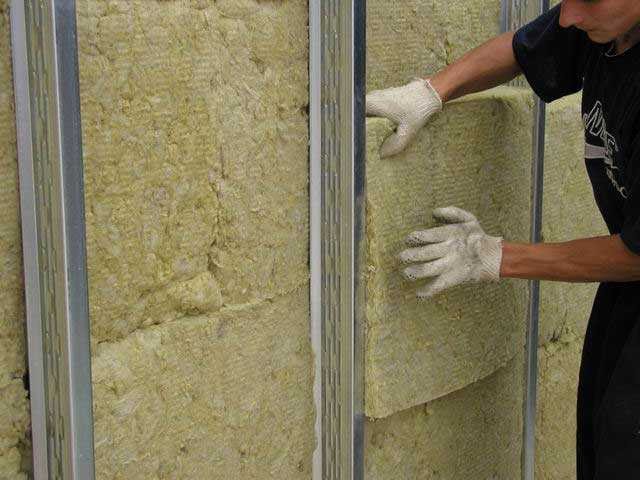

When building frame houses, special attention should be paid to the steam and waterproofing of the walls.
The penetration of moisture into the framework is unacceptable. It is necessary to reliably protect the insulation from external adverse environmental influences, such as: the formation of condensation due to an insufficient level of vapor barrier, as well as the penetration of warm air from the heated room, increased humidification as a result of moisture penetration through the outer skin of the building. Capillary suction of ground water brings no less harm.
Rigid mats and boards are used for protection. Due to the fact that there is no ventilation gap in the structures, there is no need to use foil mats and plates.
Basalt wool is a time-tested thermal insulation, but it is very important that when insulating frame houses, the width of the slabs used should exceed the distance between the inside of the frame by 2 cm. This will reliably fix the used material.
The main advantage of basalt wool, in comparison with fiberglass, is its high density, which allows the building material to withstand heavy loads.
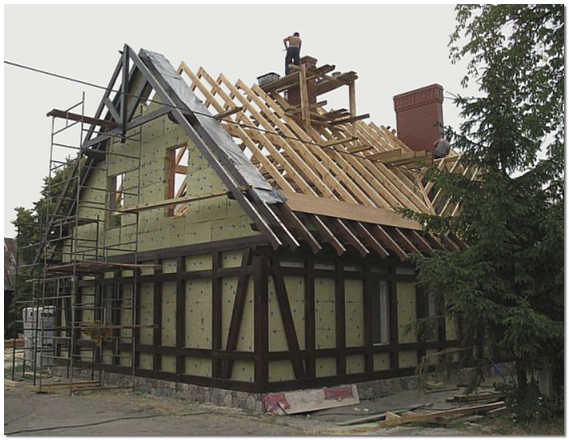

Basalt insulation is very popular in the construction of industrial, commercial and private buildings. Such popularity of this material among specialists and ordinary people is explained by the fact that this material is characterized by a number of unique properties, among which the following attracts attention:
Fire safety. The material is non-flammable and able to resist the spread of fire.
Even under the influence of high temperatures, it does not release substances harmful to the human body; Moisture resistance. The material is not hygroscopic. Even without additional waterproofing, it prevents the accumulation of moisture; Frost resistance.
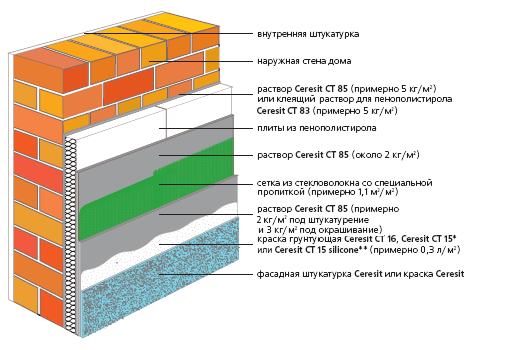

The listed characteristics make it possible to widely use this material for facade insulation. This article will consider the options for using basalt wool and basalt slabs. In particular:
Types of basalt insulation and their characteristics
Basalt insulation is made from thin (BTV) and superfine (STBF) fibers. Fiber technologies differ in the melting temperature of minerals (up to 700 or up to 1600 degrees). The final product consists of 95% natural fibers and 5% synthetic binders. Insulation based on BTW has the following characteristics:
- fiber thickness 4 - 15 microns with a length of up to 1500 mm;
- operating temperature range: -260 - + 700 degrees;
- thermal conductivity: from 0.06 W / m * K.
Insulation based on STBF has the best characteristics:
- fiber diameter: 1 - 3 microns;
- operating temperatures - up to 900 degrees;
- thermal conductivity: from 0.04 W / m * K.
- Read about the features of Izospan heat and vapor insulation in our article.
- This publication will guide you through all the steps in the DIY roof waterproofing process.
- You will learn about the purpose of roofing aerators, their types of design and installation technology at this link.
Both types of basalt insulation surpass mineral wool in strength, durability, operating temperature range and moisture resistance. The advantages of these materials are:
- good sound insulation (sound absorption coefficient at a thickness of 5 cm: 0.32 - 1.0);
- vapor permeability;
- hygroscopicity up to 0.3%;
- environmental safety at all temperatures;
- resistance to aggressive environments;
- ease of cutting;
- light weight: 40 - 130 kg / cu. meter;
- service life 50 years;
- incombustibility.
Basalt heaters are produced in slabs, tufted and lamellar mats. Thermal insulation characteristics deteriorate with increasing density, while the strength of the boards increases.... The cost of one cubic meter of basalt wool, depending on the density, is 1300 - 5500 rubles. The price of foam is in the lower section of this range, but the consumer properties of stone insulation are much higher and the cost of purchasing basalt slabs is quite justified.
Facade insulation technology with basalt wool
Basalt wool is used to insulate facades, which will be additionally sheathed with finishing material. This material is most widely used for insulating facades covered with siding.
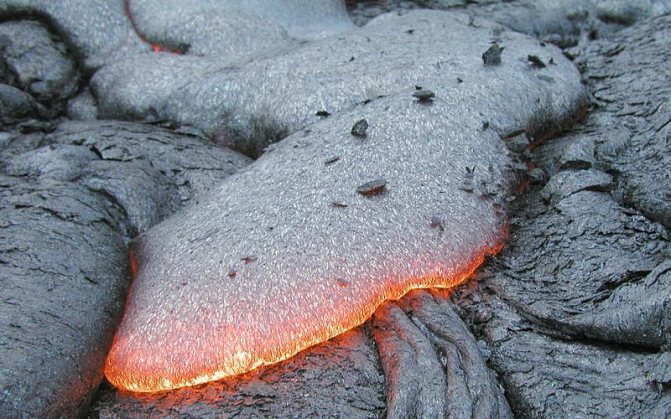

The density of basalt wool should be at least 90–135 kg per cubic meter. m. It is not recommended to use a material of lower density due to the fact that, in this case, there is a possibility of the insulation slipping.
In addition, the thermal insulation characteristics of a less dense material are significantly lower. In any case, the installation of a basalt wool insulation layer requires the manufacture of a reliable frame. It is better if the frame is double, this will eliminate the “cold bridges” in the insulating layer.
Modern industry produces basalt wool in rolls, sheets and cylinders. The most convenient for insulating the walls of a private house are sheets. As a rule, in hardware stores you will be offered the following sizes of basalt wool: 1000 × 500 × 500 millimeters.
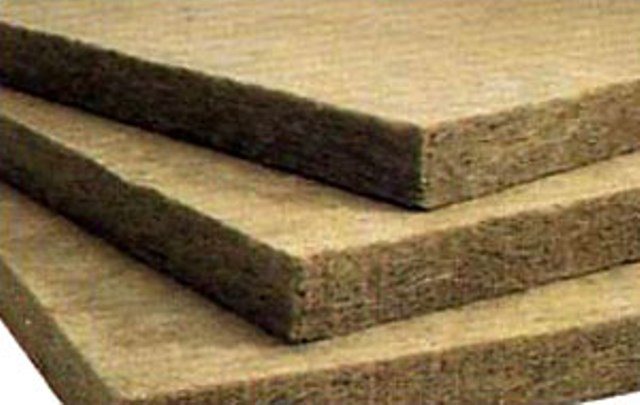

The thickness of the basalt wool is a multiple of 50 millimeters. The thermal conductivity of this material ranges from 0.032 to 0.048 W / mK and is identical to the thermal conductivity of foam, foam rubber and cork. Basalt wool is characterized by high vapor permeability, which ensures good moisture exchange with the environment.
The technology of installing an insulating layer based on basalt wool is quite simple and does not require the use of special equipment. With free time and desire, you can do the insulation of the facade with basalt wool with your own hands. The installation algorithm when working with selected materials includes two stages:
- Installation of the frame (lathing); Laying the insulation material.
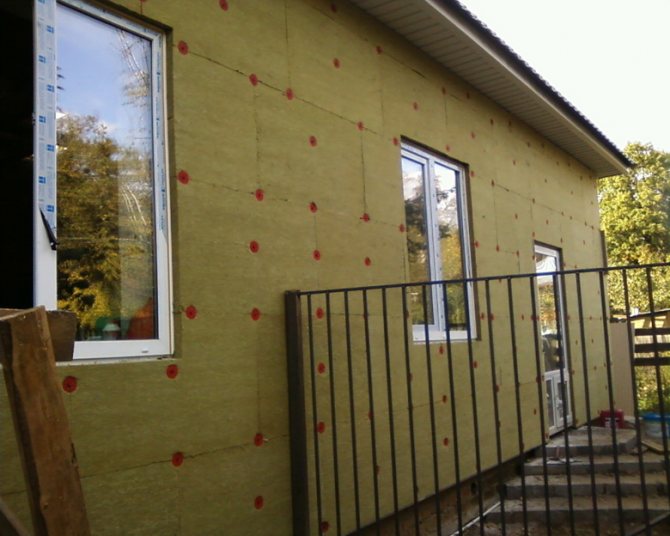

The frame (lathing) of the insulation structure is made of a metal profile or wooden beams.
Its thickness directly depends on the thickness of the insulation, the width of the cells on the size of the sheet of basalt wool. There are a number of factors to consider when choosing the material that is best suited for the fabrication of the frame. In particular: wall material, climatic conditions (rainfall, wind load, etc.).
In most cases, in private construction, a wooden beam or a galvanized profile is used. All other things being equal, preference should be given to the profile. If the choice when searching for a material is made in favor of a wooden frame, then before installation it is necessary to carefully treat all the wooden parts of the frame with antiseptics and fire retardants.
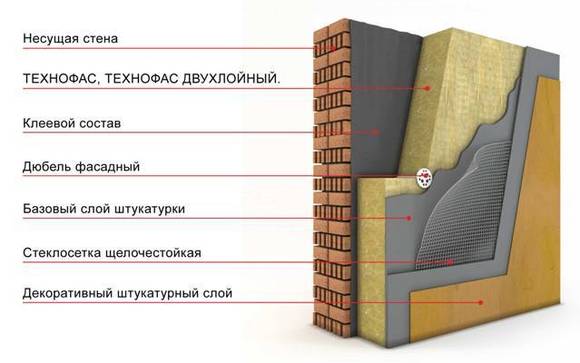

The insulation should be placed between the frame beams as tightly as possible. If the insulation material requires additional waterproofing, then a polyethylene film is used for these purposes.
Advantages and disadvantages of the material
Let's start our assessment of basalt mineral wool by listing the advantages:
- The material is non-flammable, does not support the spread of fire, does not melt.
- Static air filling the space between the fibers makes stone wool an excellent heat and sound insulator.
- Insulation is an environmentally friendly, biologically stable and safe material for health.
- Differs in durability.
- It is a universal insulator for any construction of walls, partitions, roofs, ceilings and floors.
- To acquire the necessary physical and mechanical properties, stone wool is produced with a density in the range of 30-220 kg / m³, can be coated with foil, fiberglass, kraft paper.
- The vapor-permeable material allows the insulated surfaces to "breathe" and remove excess moisture from them in time.
- Ease of handling, transportation and installation.
Against the background of the above list, minor shortcomings are lost: a decent cost and an increased weight compared to other types of cotton wool.
More information about basalt wool in the following video:
Facade insulation technology with basalt slabs
Basalt slabs, due to their high strength and resistance to weathering, are the best options for insulation material for external thermal insulation systems in private houses. Their use makes it possible to significantly expand the scope for technical and design solutions related to facade decoration.
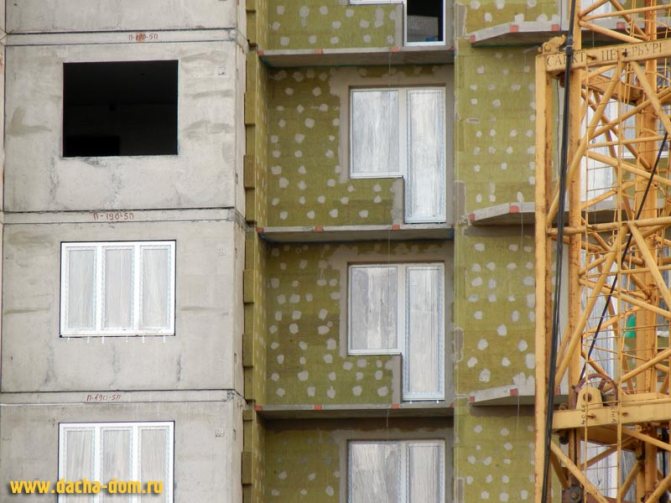

This building material is used (as insulation) in the "wet facade" technology.
The surface of basalt slabs can be treated with quartz soil, decorative plaster, silicate and silicone paints. When choosing paint, it is better to give preference to silicone-based solutions. Such paints do not impede the flow of air into the surface of the facade, in other words, they allow the facade to "breathe".
Basalt fiber slabs are characterized by all the physical, chemical and operational characteristics of mineral wool. They do not contain any additives in their structure.
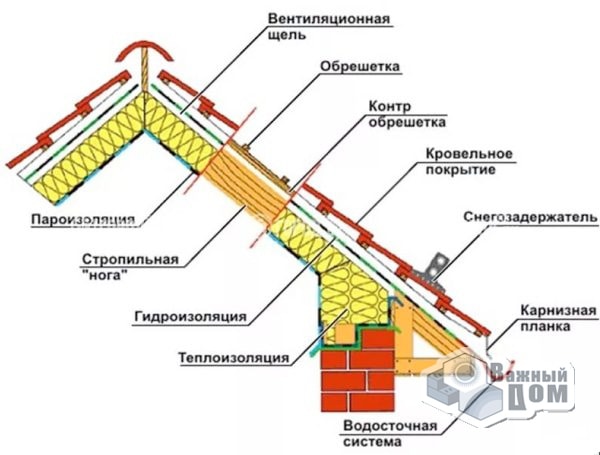

A distinctive feature of basalt slabs is the high manufacturability of this building material. It is easy to transport, store and install.
Warming the facade with basalt slabs with your own hands is within the power of a person who does not have special skills and knowledge. In addition, like mineral wool, the installation process does not require special equipment. Despite the rather high density of the slabs, they can be cut with an ordinary kitchen knife.
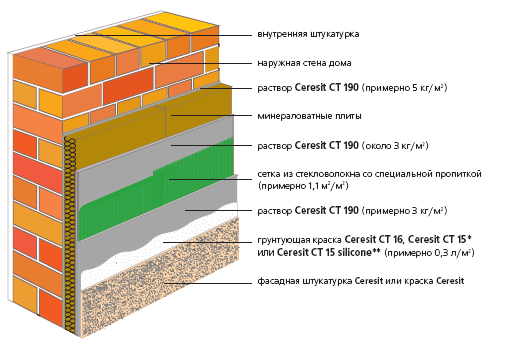

The thermal conductivity coefficient of basalt fiber slabs is in the range of 0.035–0.043 W / m * K, which almost corresponds to the indicators of basalt wool. The vapor permeability indicators of these materials are also identical. Due to their denser structure, basalt slabs have good sound insulation properties.
When installing an insulating layer "under plaster", two types of basalt slabs are used - with a random arrangement of fibers and a slab with an arrangement of fibers perpendicular to the wall plane, and the dimensions of the slabs are mainly 120 × 20 cm.
The process of installing basalt slabs "under plaster" has some peculiarities at the stage of laying the insulation. Plates are glued to the walls using special glue and additionally fixed with umbrella dowels. After installing the entire surface of the insulation, the plates are covered with an adhesive solution and reinforced with a special mesh.
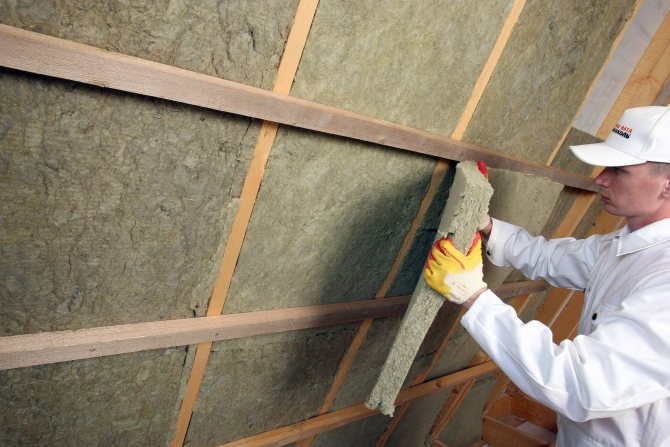

Plates, to a lesser extent than cotton wool, are demanding on the accuracy of the geometric parameters of the frame, but this should not be abused - a tight fit of the insulation to the lathing machines is necessary to ensure a reliable thermal insulation layer.
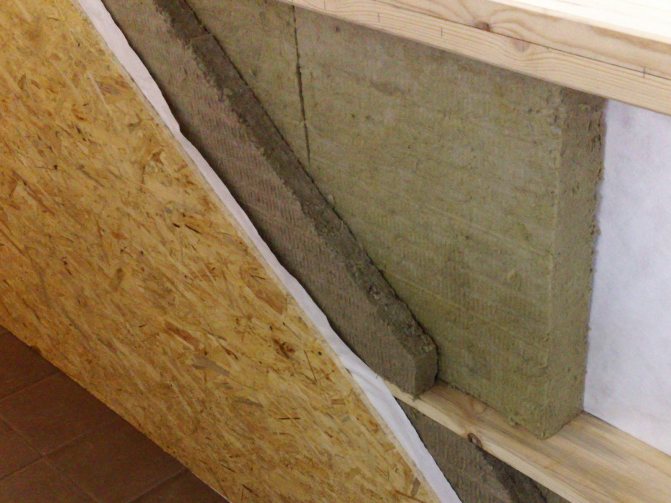

- Date: 17-09-2015Rating: 33
Basalt insulation has natural materials in its structure.
It is based on the material of volcanic rocks and is produced in the form of heat-insulating plates that help to insulate walls and facades. Basalt slabs are insulation in the form of panels that have a fairly rigid fibrous structure. This structure contains basalt fibrous threads, which are linked by various additives and synthetic elements.
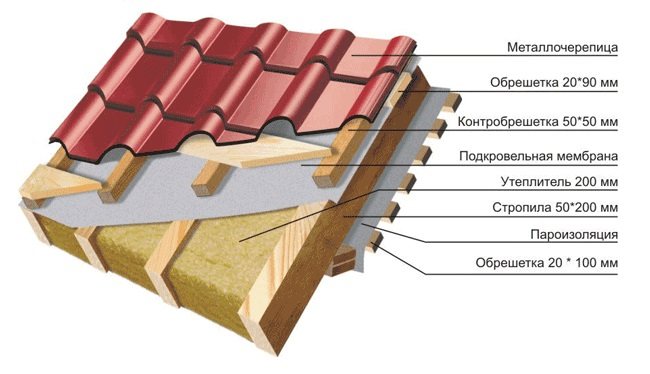

Basalt insulation is made from volcanic rocks by high-temperature melting and subsequent blowing.
One of the important components of any private house is its insulation. Thermal insulation of the house allows you to keep it cozy and comfortable.
The use of basalt will fully help to achieve this task. The experience of using it has shown that such wall insulation is not only reliable and safe, but also fireproof. Those. it can be used for almost any room.
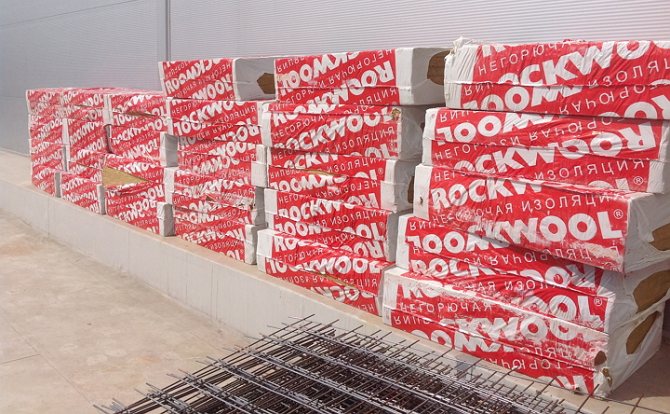

Various forms of basalt insulation make it possible to insulate various structures.
The raw material for such a material is a thin fiber from rocks of magmatic origin. These include basalt, andesite, diabase, etc. In the process of high-temperature melting of these materials (1400-1600 degrees) and their subsequent blowing with the help of a high-speed gas jet, the molten mass is gradually converted into staple fibers.
Next, the resulting fibers are placed in a drum. There, the threads are intertwined in a chaotic state and reach the required density. After cooling to 200 degrees, the resulting mass hardens, and it is given the desired shape.
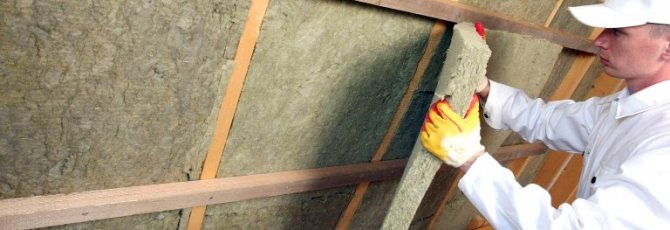

Its form can be of several types:
- Material in the form of slabs (has a formed structure of various thicknesses and areas). Bulk material (made by granules that have different densities and sizes). Basalt wool (made in the form of soft rectangular tiles). Shapes in the form of mats (they consist of quilted fibers, to eliminate the loss of their shape) .Lamellar forms (can be square and rectangular). Basalt fabric (in rolls).
All these materials will provide sufficient protection for the house from freezing, but basalt slabs, due to their ready-made shapes and sufficient thickness, are the most convenient.
Back to the table of contents
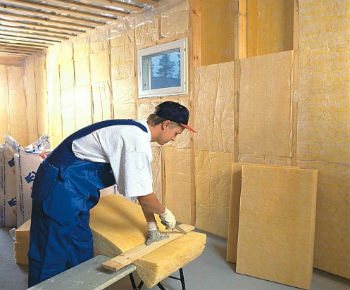

Scheme of roof insulation made of metal tiles.
The procedure for laying the material for thermal protection of the house must be developed at the stage of its design.
It is necessary to immediately determine the possible places of heat leakage. In each house, they will be their own because of its architectural features and location. The most challenging areas will be the attic, roof, slabs and façade.
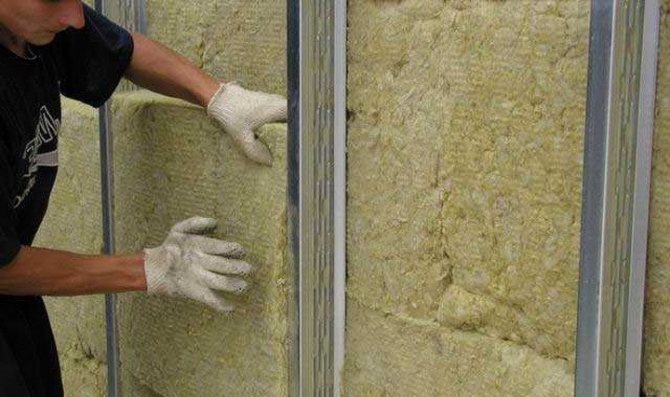

When laying basalt slabs that provide thermal protection to the roof, it is necessary to use a film to create a vapor barrier. It should be laid on horizontal bars between the rafters.
The resulting joints must be sealed with a special tape. The thickness of the layer to be laid should be 180-200 mm.Next, you need to lay a layer of wind protection and make a crate with beams (to ensure ventilation).
In the process of insulating the attic, the insulation must be laid between the logs that are on the floor of the attic. The equal distance between them will ensure the ease of laying basalt slabs. And the resulting gaps need to be covered with cellulose insulation.
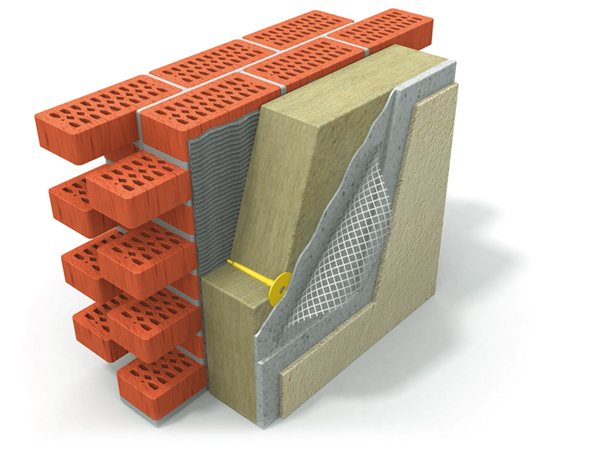

Scheme of wall insulation of a frame house.
Insulation of the floor and ceiling will provide not only their thermal, but also sound insulation. During the work, slabs of material are laid on the floors. The vapor barrier membrane must first be decomposed on them.
The subfloor is laid on this structure. It should be made of moisture resistant plywood (OSB plywood, etc.). After that, you need to lay the substrate, and on it - the desired floor covering.
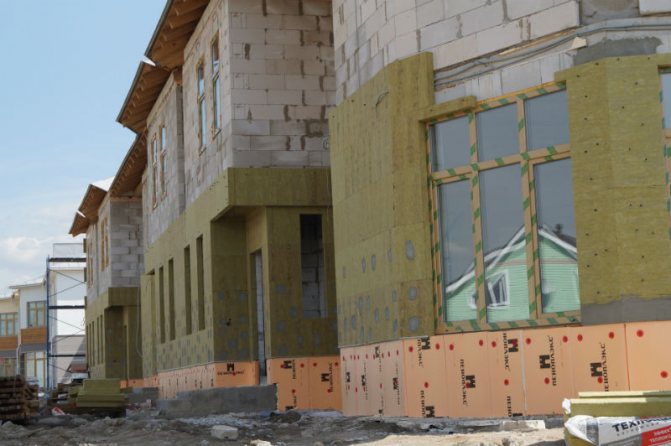

In the course of insulating the walls of the building, the facades are insulated at the same time. Basalt slabs can be used to insulate both the inner side of the wall and the outer one. The order of their insulation is slightly different.
For internal work, it is necessary to initially make a crate of the surface. The step of the lathing should be 60 cm. This width was not chosen by chance, because
because the slabs are of exactly this size. An impervious film is laid on top of the insulation, and the interior decoration is made with it.
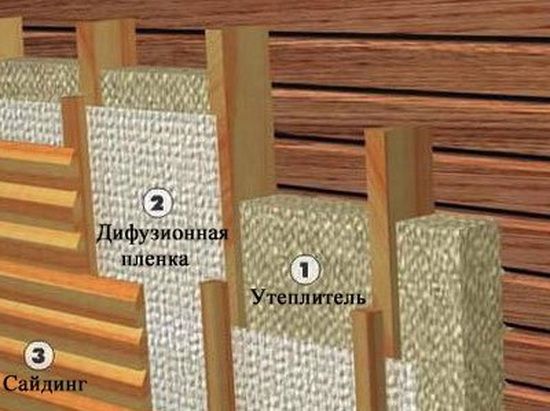

When insulating the walls from the outside, you need to do their preliminary crate. The basalt slab is laid with a slight gap from the final cladding to provide ventilation. It is attached to the base of the wall with self-tapping screws.
Then the windproof film is laid. The work is completed by finishing with siding or any other external coating material (lining, porcelain stoneware, etc.).
Back to the table of contents
Insulation scheme for the external facade of the building.
The peculiarity and advantage of such a material for keeping warm in the house is its versatility. Basalt can be used for both exterior and interior decoration. Moreover, it is completely harmless and environmentally friendly.
It contains no phenolic compounds, the fumes of which are very harmful. They can lead to various diseases. The use of this material leads to a decrease in the total cost of heating the house by an average of 60-65%.
Plates made of this material retain heat very well, since they have a rather low thermal conductivity. At the same time, they protect the room from excessive moisture penetration into it. Therefore, the combination of these factors together allows you to ensure good air circulation and create a comfortable environment in the house.
The construction of basalt slabs is such that their installation will not cause much trouble. They have a fairly reliable and durable structure.
Therefore, they can withstand fairly strong loads without deforming and retaining their appearance. With a competent approach to work on insulation and skillful handling of the assembly tool, you can quickly complete the fastening of this coating.
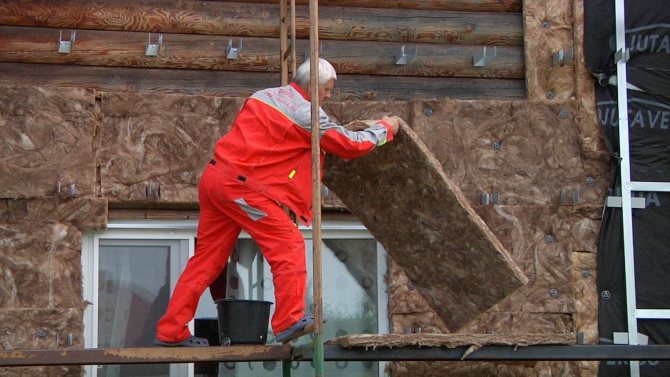

Various materials are used to insulate the facade of a house from a bar.
Nowadays, basalt thermal insulation boards are considered the best materials for insulating the walls of the house from the outside. Mineral wool and foam are also often used, but the first material is not so environmentally friendly, and the second does not breathe. Insulation of the facade with basalt slabs: video and photo materials about insulation in one article.
Basalt insulation installation process
Wooden log cabins for a bath do not need additional internal insulation. And in cases with the use of other building materials and construction technologies, the thermal insulation process is different.
Insulation of walls in block buildings
The walls of the bathhouse made of bricks and other artificial stone of the block type are insulated according to the general scheme. Let's list the main stages of work:
- A frame is pre-mounted on the wall with a pitch of beams or profiles, which ensures tight laying of the wool slabs between them.
- Insulation plates are placed in the finished frame. For reliability, they can be fixed with umbrella-shaped dowels.
- Any gaps and gaps noticed are sealed with polyurethane foam.
- Over the entire area, the walls are laid with an overlap of vapor barrier canvases (preferably foil-clad). The joints are glued with special tape.
- If the frame and basalt wool are of the same thickness, an additional crate of thin strips is stuffed on top of the beams to organize the ventilation gap.
- Carry out the inner lining of the steam room with wooden clapboard. Aspen wood has minimal thermal conductivity and is traditionally used for this purpose.
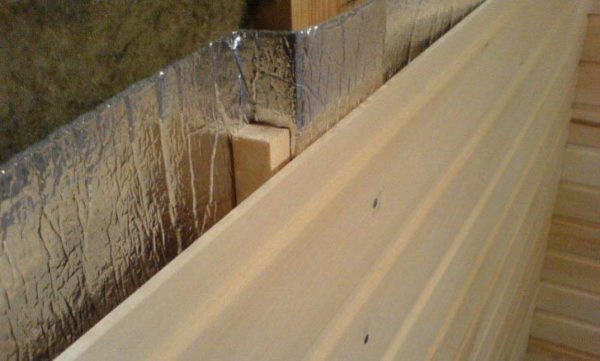

Illustration of the layers of the "pie" for the internal insulation of the walls of the bath
Block materials, especially lightweight porous concrete, are hygroscopic. Their external protection will also be required.
More about working with basalt wool:
Insulation of frame baths
Prefabricated frame baths do not require large investments and labor costs, therefore they are in high demand. With high-quality insulation, they are practically not inferior to steam rooms from a log house. Basalt wool with a thickness of up to 15 cm is used to fill the openings between the elements of the wooden frame.
Step-by-step process of warming:
- Installation from the outside of the frame of the film hydro-wind protection.
- Laying stone wool.
- Protection of the insulation from the inside with a vapor barrier material (it is possible with a foil surface).
- Sheathing of the frame with wooden clapboard on both sides.
- Treatment of external cladding with protective impregnations or painting.
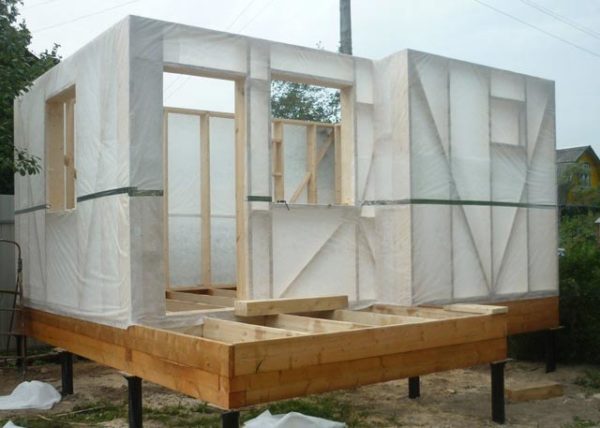

Bath frame with external waterproof film
The versatility of natural basalt wool has been proven by the practice of insulating any structural elements of a building made of various building materials with its help. Due to its unique characteristics, environmental friendliness and safety for humans, it has deservedly become a win-win, the best option for internal insulation of a bath.
Basalt insulation pros and cons
Basalt slabs are made of mineral fibers pressed into slabs.
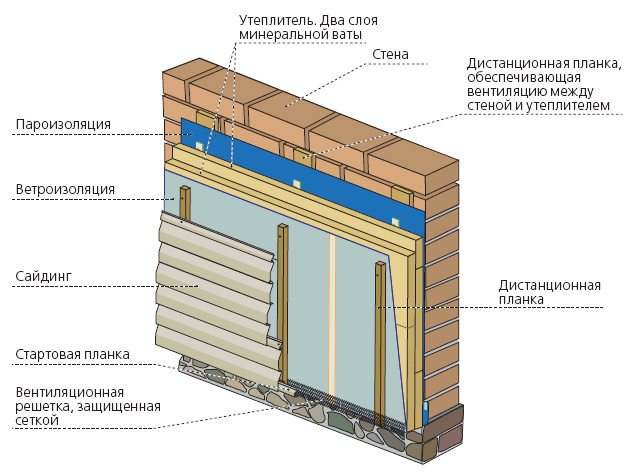

The fibers are interconnected with an adhesive based on various resins. It is made from natural raw materials. Basalt slabs can be used to decorate any living space, as well as food and childcare facilities.
Quite often, this heat insulator is used when decorating private houses and cottages from timber, air ducts and other structural elements. The use of basalt wool is often necessary to provide thermal insulation for industrial equipment (boilers, furnaces, boilers). Basalt slabs can be used as light sound and thermal insulation in a horizontal fencing structure of any type of buildings and structures.
The main advantages of insulation include:
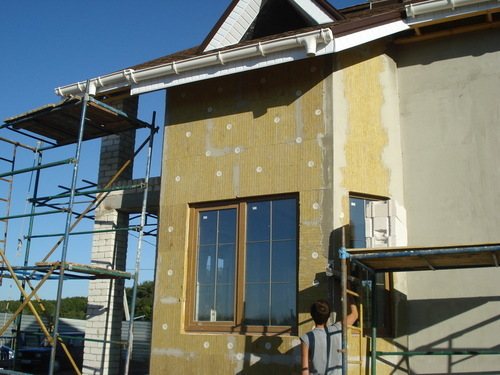

- Lightweight. Does not burn. High heat and sound insulating properties. Suitable for most types of finishes. Elastic material, so it does not break and is not afraid of mechanical stress. Does not collapse from moisture like glass wool. Eco-friendly. Does not block the flow of oxygen into the house, which does not disturb the microclimate wooden house. Easily mounted on any surface. There is no need to level the insulated surface.
Cons of basalt mineral slab insulation:
- The price for the material is higher than for mineral wool or foam. Not every glue can be attached to a wooden facade.
Facade preparation
Before starting work on warming the facade of a wooden house with basalt slabs, it is imperative to inspect the outer walls of the house, its basement and roof. To do this, you need to pay attention to the following actions:
- Look for visible cracks and damage at the junction of the foundation and the first crown, in window and door openings, walls. Look for strong bulges and curvatures, if necessary, cut, put guide bars 2 m long, 40x40 mm section on top. and finish the basement of the house with waterproofing materials, for example, roofing material or coating compounds: liquid glass, bitumen mastic. Clean the surface of the walls of the house from contamination, if there is an old sheathing, dismantle.
Installation of slabs on the facade of the house
Basalt slabs are installed wet and dry.
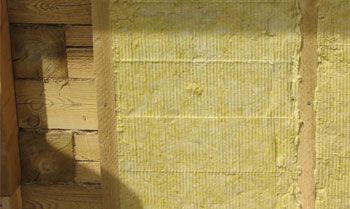

For a wooden house from a bar, it is better to choose a dry one, when the material is attached to the facade using a dowel of nails with a wide head. If the wet method is chosen, then a silicone-based adhesive and quartz sand is used. The fact is that it is more difficult to glue plates to wood than, for example, to cement or brick.
Basalt slabs for the facade of your house are taken with a density of at least 90-135 kg per cubic meter. m. The use of building material with a lower density is not worth it, as it is soft and can slide over time from a vertical wall.
Fastening the material along the entire facade is laborious, so not everyone can do it with their own hands. Basalt slabs will not only protect a wooden house from the cold, but also give it sound insulation no worse than a foam finish.
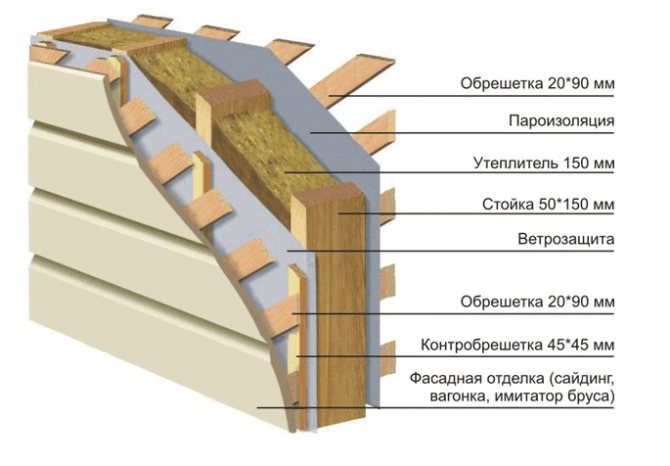

The only thing you should pay attention to is the weight of the plates. It is higher than that of polystyrene, therefore, even with the wet method, it is recommended to additionally secure the material with mushroom nails. More details on how the facade is insulated with basalt wool, in the video:
Installation of mats is carried out in accordance with the selected facing material. The following technologies are used for painting and plastering:
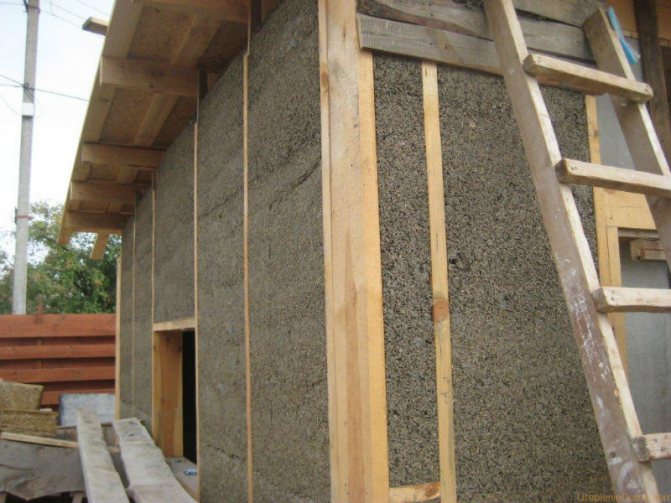

Horizontal strips are mounted on the plinth, they are needed so that the insulation does not slide down and lie flat.
It is necessary to fasten the planks strictly according to the level.Fix the material starting from the corners of the house around the entire perimeter, below the plank. (the method resembles a strapping). Since the standard height of the insulation is 50-60 cm, and the thickness is 20-100 mm, a belt of these dimensions will be obtained. The next stage is to attach the second row of plates, while it is necessary that it is located with the first in a checkerboard pattern. On top of the plate, cover with a hydro-vapor barrier and a reinforced mesh Then the structure is plastered and painted.
Installation under panels (siding, block house, lining, imitation of a bar):
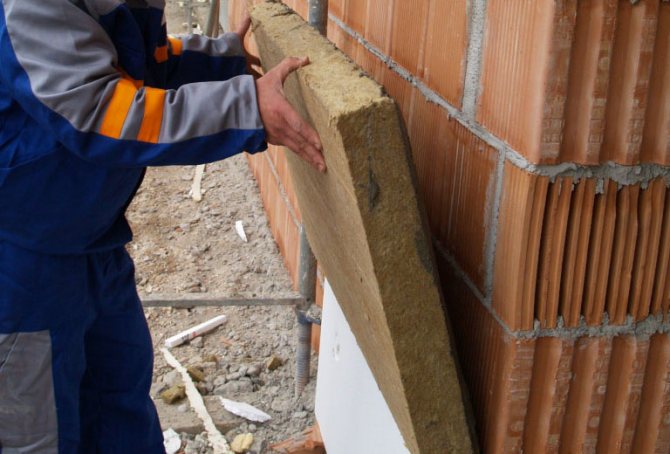

A crate is attached to the walls (vertically) from a bar or metal profiles with a step of 60 cm. To fasten the crate, you must start from the corners of the house, fixing on each side of the bar. Boards. From the bottom between the crate, guide bars 60 cm long are attached, they will support the heat insulator. Between the crate, a basalt slab is mounted.
It is fastened with dowels with a wide head. A hydro-vapor barrier is laid on top. It is mounted with a construction stapler directly to the lathing. The counter lathing is attached to the lathing. It is necessary in order to create an air gap in the structure. Facing material is attached to the counter-batten.
Price for facade insulation with slabs
The price for facade insulation with basalt slabs exceeds mineral wool or foam. The fact is that it is heavier and it is not enough to simply lay it between the crate. A lot of fasteners are also needed, the price is quite high. Not all construction crews are able to work with basalt slabs, since the material is relatively new. When choosing workers, ask to show a photo with work already completed or the coordinates of those who have been insulated. The fact is that with improper installation of expensive material, and its price starts from 500 r / m2, you can get a low-quality facade that will accumulate condensate and let the cold pass. The price of the material is presented in the table below:
| Brand | PC. packaged | Slab volume, m³ | Covered area, m2 | Length, mm | Width, mm | Thickness, mm | Price, p. |
| Ursa 15P | 24 | 0,9 | 18 | 1250 | 600 | 50 | From 3800 |
| 12 | 0,9 | 9 | 1250 | 600 | 100 | From 2000 | |
| Ursa 30P | 20 | 0,75 | 15,00 | 1250 | 600 | 50 | From 4900 |
| 16 | 0,72 | 12,00 | 1250 | 600 | 60 | From 4200 | |
| 14 | 0,735 | 10,50 | 1250 | 600 | 70 | From 4000 | |
| 12 | 0,72 | 9,00 | 1250 | 600 | 80 | From 3200 | |
| 10 | 0,75 | 7,50 | 1250 | 600 | 100 | From 3000 |
The price of work in different cities differs by 200-300 rubles / m2. This difference is due to the cost of services on the market in Moscow, St. Petersburg, N-Novgorod, Kazan, Ufa, where prices are higher than in small towns. The table below shows the average price for work:
| Type of work | Price, rubles / m2 |
| Wet installation of basalt slabs | From 650 |
| Installation of basalt slabs under the crate | From 1100 |
| Facade preparation | From 300 |
Having counted the square meters of the entire facade, it becomes clear that doing the work with your own hands is much more profitable. And having carried out the installation correctly, you can count on getting good heat and sound insulation. Basalt slab is thermal insulation that can protect any wooden house from frost in the coldest winters. Choosing this expensive and high-quality insulation, you can be sure of a good result.
Insulation of the frame structure
Basalt insulation near
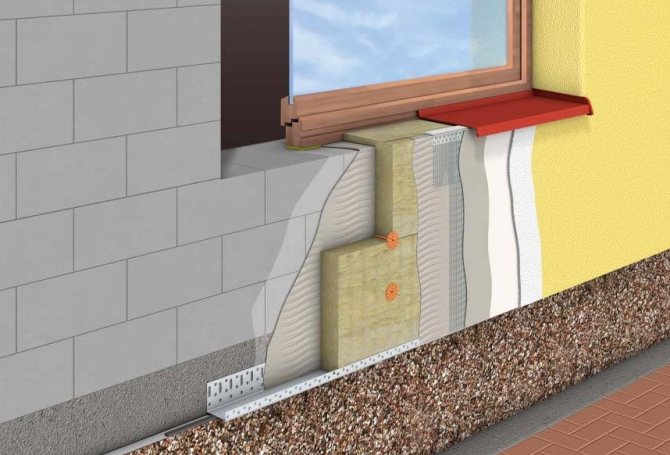

Basalt slabs are considered the best heat insulator for a timber frame house.
It is necessary to mount the insulation outside the structure, since during the interior decoration the frame remains unprotected and condensation will accumulate between the heat insulator and the timber. It gets into the capillaries of wood and will cause rapid decay and mold. When insulating frame houses, special attention should be paid to the vapor and waterproofing of the structure.
The penetration of moisture inside the house is unacceptable. In this case, the design of the facade finishing must be ventilated.
Since the temperature difference between the inside and outside of the building will be significant in winter, condensation may form. For better insulation, you can use basalt slabs foiled on one side. The price for them is higher, but the house will be protected from moisture.
At the same time, it is necessary to qualitatively waterproof the foundation of the house, since the tree will absorb moisture from the foundation and it will be difficult for it to erode from the structure with slabs. A basalt slab with a thickness of more than 2 cm is chosen for insulating a wooden frame house, or it is necessary to make a double structure.
Scheme of warming a frame house with mineral wool: features and nuances
Insulation of a frame house - one of the most important stages of construction, since the insulation layer serves as the only barrier to the penetration of cold into the home, as well as an insulator from wind and moisture.
AND up to 80% all frame houses are insulated with mineral wool or materials based on it.
Mineral wool and its features as insulation
Mineral wool - This is a vapor-permeable insulation, which is the most popular material for thermal insulation. Minvata is distinguished by high sound insulation and environmental friendliness. Throughout the entire period of use, the mineral wool remains in its original form.
Advantages and disadvantages
Main advantages mineral wool:
- Low thermal conductivity. This coefficient depends on the density of the mineral wool and can range from 0.032 to 0.039 W / (m * K). And the tougher the cotton wool, the less thermal conductivity it will have.
- Durability. With proper installation, the insulation can last up to 70 years.
- Ease of installation. The material is easy to cut with a knife and easy to handle.
- Fire safety. Minvata does not burn, but only melts under the influence of high temperatures, while not emitting harmful substances into the atmosphere.
To the disadvantages mineral wool insulation includes:
- High cost.
- The need to protect the material from moisture using a vapor and waterproofing film.
- The installation of cotton wool slabs must be carried out in a suit and a respirator to protect against harmful dust.
Types of mineral wool, their pros and cons
Mineral wool happens 3 types:
- Glass wool (glass melts are used as raw materials).
- Stone (made from rocks).
- Slag (produced from slag).
The previously described advantages and disadvantages mineral wool is inherent in all its varieties, the following shows the distinctive pros and cons of each type.
Glass wool Is a fibrous insulation, which is a type of mineral wool. The raw materials for its manufacture are glass melts and binders - resins.
Pros of glass wool:
- Air permeability.
- Frost resistance.
- Resistant to chemicals.
- Resistant to mold and fungi.
Cons of insulation:
- Short service life - up to 10 years.
- Shrinkage up to 80%.
Stone (basalt) wool Is a vapor-permeable insulation, which is one of the best sound and heat insulation materials. It is made from rocks with the addition of urea resins and bentonite clay.
Pros of stone wool:
- High density.
- Minimal shrinkage (about 5%).
- Resistant to decay, mildew and mildew.
To the disadvantages can be attributed to the high moisture absorption of stone wool.
Important: cotton wool is produced in slabs and rolls, it can have different density - from 30 to 100 kg / m³.
Slag wool is made from blast-furnace slag, which is a waste of metallurgical production.
Pros are slag:
- flexibility and elasticity (can be used to insulate rounded surfaces).
- Low cost.
Cons of insulation:
- When water hits the cotton wool, acid is released, which destroys the metal.
- The material does not tolerate temperature extremes.
Table 1... Characteristics of various types of mineral wool
| Parameters | Glass wool | Stone wool | Slag |
| Thermal conductivity coefficient, W / (m * C) | 0,037-0,041 | 0,032-0,048 | 0,046-0,048 |
| Vapor permeability coefficient, mg / (m * hour * Pa) | 0,60 | 0,3 | 0,6 |
| Density, kg / m³ | 11-130 | 30-100 | 75-200 |
| Moisture absorption,% | 0,55-1 | 2 | up to 2 |
| Sound absorption | high | high | good |
The table shows that stone wool has the best technical indicators, plus everything has minimal shrinkage. Slag wool is noticeably inferior to glass and stone wool in terms of thermal conductivity and has low noise insulation.
Floor insulation technology of a frame house
Floor insulation technology based on the type of foundation of the house. Most of the frame structures are placed on a pile-screw foundation, but regardless of the type of foundation of the house, the first layer of floor insulation should be waterproofing.
If the house is located high from the ground and you can climb under it, then first attach it with a stapler under the logs from below waterproofing film, and then the bottom sheathing boards are nailed.
They can be nailed close to each other or in increments of up to 40 cm... They will keep the mineral wool slabs and the waterproofing film from falling down.
If you can't crawl under the house, then boards are stuffed under the logs, and then a film is laid on top of the logs and boards from the inside. Minvata fits tightly between the lags on the film... Distance between lags should be 58-59 cm, since the standard width of cotton wool slabs is 60 cm.
Average thickness of the layer of mineral wool should be 15 cm, and the height of the lag is slightly less. Each new layer of cotton wool should overlap the joints of the previous one and have an overlap of at least 20 cm.
On top of mineral wool and lag attach a vapor barrier film, glue the joints with 2-sided tape. Sheets of plywood, OSB or boards are laid on the film, which will serve as the basis for the finishing of the floors.
Important: waterproof and vapor barrier films are laid so that their edges go over the walls. This will exclude the ingress of moisture between the wall and the floor of the frame house.
Scheme of warming the walls of a frame house with mineral wool
The walls in the frame house are insulated and outside and inside... The materials for this are the same.
Insulation of external walls
Wall insulation technology mineral wool outside includes several stages. First, the frame is sheathed from the outside with OSB boards with a distance between the boards of 2-3 mm. Then these slots are filled with polyurethane foam.
Outside, over the slabs, a waterproofing film is pulled to protect slabs and a layer of mineral wool from precipitation, the joints of the films are double-sided tape.
Next, the finishing is done, which is often the role of siding panels. To do this, build on the walls on top of the film frame made of beamsto which the siding panels are attached.
On the inside, between the beams of the frame, mineral wool slabs are inserted. The joint of the second layer of cotton wool should overlap the joint of the first 15-20 cm.
Advice: it is best to take slabs of wool with a density of at least 35-50 kg / m³ to insulate the walls of a frame dwelling. Such mineral wool will not sag and roll down.
After laying all the insulation must be filled with polyurethane foam all the cracks that appeared at the joints of the boards and beams.
On top of a layer of mineral wool a vapor barrier film is stretched from the inside to protect the insulation from moisture coming from inside the room. Next, OSB sheets, plywood or boards are stuffed onto the film. Finally, the walls are finished.
Insulation of internal walls
Insulation of internal walls frame house is mainly carried out to provide sound insulation. To do this, you can use mineral wool, another type of insulation or special soundproofing materials.
The technology of wall insulation inside is similar to the insulation of external walls, while hydro and thermal insulation films you can not apply.
Ceiling insulation with mineral wool
Ceiling insulation is one of the most critical stages in the technology of home insulation. It is recommended to carry it out while the roof is not yet fully assembled, so that it does not interfere with the dense laying of the mineral wool from above to the ceiling.
First, a vapor barrier film is attached to the ceiling beams from the inside. A board is nailed onto it 2.5 cm thick, plywood sheet or OSB board. Next, slabs of cotton wool are attached on top according to the same rules as for wall and floor insulation.
Attention: mineral wool is placed completely along the entire ceiling, plus an overlap on the entire width of the walls.
If the attic is not used for living, then there is no need to lay membrane films. Can be sheathed immediately with plywood or plank for ease of movement. In the case when it is not possible to insulate the ceiling from above, it is applied insulation from the inside... For this, mineral wool slabs are tied to the ceiling. Then a vapor barrier film and plywood sheets or boards are sewn on.
Since warm air always rises to the top, then with illiterate insulation the ceiling will leave a large amount of heat from the room.
Insulation of the roof of a frame house
Roof insulation technology similar to ceiling insulation with one exception. A waterproofing film must be laid on the layer of insulation to protect the mineral wool from the external environment (rain, wind or snow).
After installation of the rafter system, a vapor barrier film is hemmed from below, onto which hemming boards or plywood sheets are stuffed from the inside.
Then, sheets of insulation are laid outside, covering them with a waterproofing film. On tape stuff the counter-lattice, then the lathing under the roof and the roofing material itself.
Roof insulation more convenient to produce outside, so the cotton fibers will not fall off on the face. If the roof is already assembled, then insulation can be done from the inside. But this is less convenient, since it will be necessary to temporarily fix the mineral wool slabs before pulling the vapor barrier.
In conclusion, we can say that insulating a frame house with mineral wool will provide minimal heat removal through the walls and cut costs for heating in winter. Mineral wool as a heater provides natural ventilation in the house and is an excellent sound insulator against noise from the street.
Look at the video for the scheme of insulating a frame house with mineral wool:
Master class on insulating the outer walls of a frame house using URSA TERRA, watch the video:

